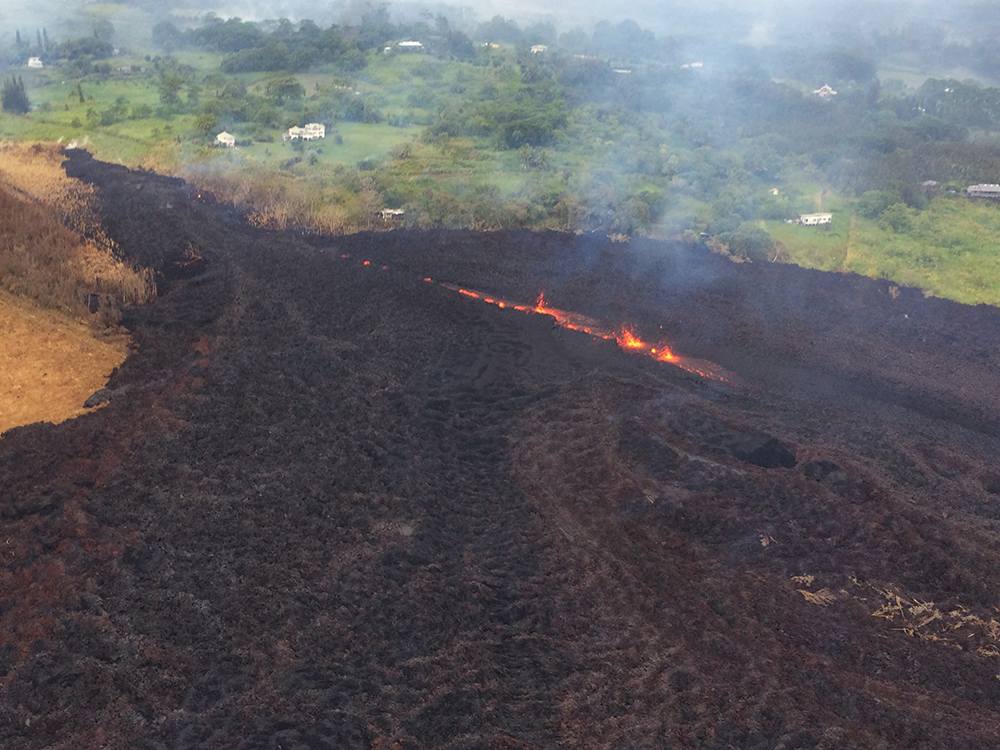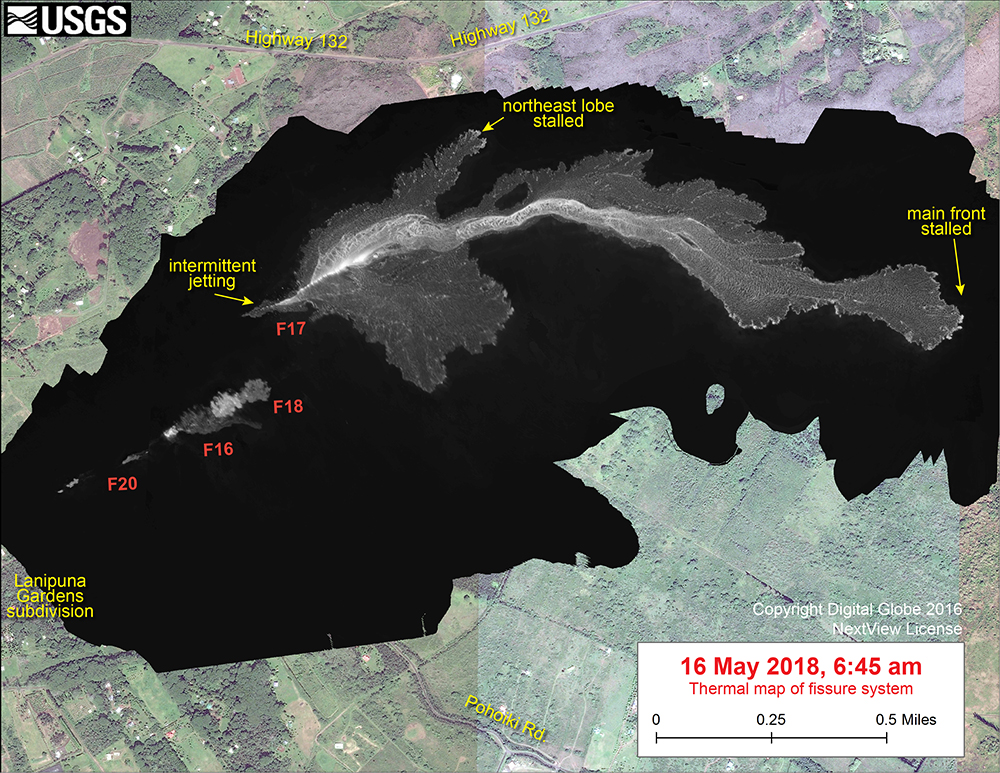Kilauea Eruption Continues: How Long Could It Last?
Posted on Categories Discover Magazine

Lava flows from Fissure 17, seen on May 17, 2018. USGS/HVO
The eruption at Kīlauea is still captivating the nation, as it should because this volcano hasn’t behaving like this in almost a century. I thought I’d take a moment to step back and review of the main events so far and what it might all mean for Kīlauea and the people who live around the volcano. These eruptions are separated by a long way if you look at the satellite data and should almost be treated at two different events.
The Leilani Estates Fissures
As we enter the third week of the fissure eruption that started in and around Leilani Estates, much of the same activity continues. More fissures have opened and now we’re up to 21 cracks opening in the ground. Lava flows, spatter and volcanic gases have dominated the eruption, with some of the flows (from fissure 8 and 17) have reached over a couple kilometers in length (see map below). The lava flow field from Fissure 17 shows multiple lava flow flows and a few channels developed in the eruption. The flows seem to have stalled, suggesting less lava erupting from the main fissure.

Thermal image of the easternmost portion of the Leilani Estates fissures. This image shows the hotter lava in lighter grey and cooled lava in black. USGS/HVO.
The earthquakes and inflation in the lower East Rift zone continues, so that means this eruption is likely not going to end anytime soon. The continued opening of fissures means that our “burst pipe” in the East Rift zone is still feeling pressure from magma moving from the summit down into the area of Leilani Estates. The question now is whether fresher, hotter magma might start erupting. The sulfur dioxide emissions from the eruption have already begun to damage vegetation in the area as well.
Un géologue analyse une importante fissure hier sur la Nohea Street de Leilani Estates à #Hawaï #Kilauea / Source : @MalikaDudley #volcano #volcan pic.twitter.com/K9N0aVFQ7I
— Actu Météo (@_Actu_Meteo) May 18, 2018
The Summit Explosions
Meanwhile, the eruption at the summit has changed dramatically. In mid-April, we were looking at a rising lava lake that eventually overflowed and covered the bottom of the Halema’uma’u crater with runny, pahoehoe lava flows. Now, here in mid-May, the summit lava lake has drained so far that the lava is interacting with the groundwater table to produce big, explosive eruptions. The largest so far was an ash plume that may have reached 9 kilometers (30,000 feet) with smaller plumes that reached 3-4 kilometers as well.
We also observed a volcanic explosion in addition to the Galactic center tonight!
From @GeminiObs cloud cam below https://t.co/qRT6EqvAZC pic.twitter.com/B2CrJPlq6w
— Tuan Do (@quantumpenguin) May 17, 2018
Now, this might seem like really tall ash plume, but in the scale of volcanoes, they aren’t even what we would call “Plinian” eruptions that reach 30-40 kilometers (98,000 to 130,000 feet)! For Kīlauea, these explosions are big and have thrown blocks of old lava as large as almost a meter across over the parking lot of the Hawaiian Volcano Observatory.
#Kilauea began tossing “ballistic blocks” up to ~60 cm across from the Overlook vent as of yest. morning local time, reflecting “the most energetic explosions yet observed.” This ash-coated block fell a few hundred meters from the vent. (photo: @USGS) https://t.co/4T1d8Akcbv pic.twitter.com/TEUAVH3AEF
— EARTH Magazine (@earthmagazine) May 17, 2018
Things that aren’t happening
A lot of rumors have been flying around about the Kīlauea eruption. Some rumors that can be dispelled:
- There will not be an avalanche that forms a “mega-tsunami” across the Pacific. Kīlauea has no record of such collapses and isn’t particularly oversteepened to cause such an landslide to happen. Kīlauea does slowly creep towards the Pacific Ocean on the east side, but it is very slow as the name implies. I think people are conflating the landslide on Kohala on the west side of the Big Island that occurred after the volcano was extinct and the landslides discussed in the Canary Islands, which form from a hotspot like Hawai’i but are steeper volcanoes.
- The eruption of Kīlauea will not trigger an eruption of Mauna Loa. The volcanoes might sit next to each other, but there are no signs of Mauna Loa becoming more active now that Kīlauea is in full eruption. In fact, there is a weak anti-correlation between Kīlauea and Mauna Loa, meaning that Mauna Loa doesn’t tend to erupt. There are very few cases anywhere on the planet where the activity at one volcano causes more volcanoes to erupt. Mauna Loa is on yellow alert for a few years of earthquake swarms that have been noticed at the volcano, suggesting magma moving under Mauna Loa, but there are no signs of an eruption in the cards.
The future
This is the big question is how long the eruption at Kīlauea will last. Right now, the best estimates are based on two things: (1) what the volcano has done in its past and (2) the monitoring data like earthquakes, inflation/deflation and volcanic gases released. If the latter continues, then we can be confident that magma is continuing to enter the system and the eruption will continue. Past eruptions — both fissure and summit explosions — have lasted weeks to months (and longer for lava flows). So, that might be the baseline with which to work. This is not good news for the people who live in Leilani Estates or downwind that might experience potential ash fall from the volcano, but it does look like what kind of eruption we might be experiencing.